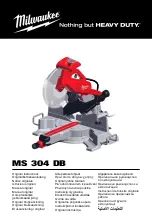
-27-
W1749 9" Bandsaw
O
PE
R
AT
IO
N
S
Bandsaw blades commonly wander off of the cut line
when sawing, as shown in
Figure 41
. This is called blade
lead. Blade lead is commonly caused by too fast of a feed
rate, a dull or abused blade, or improper tension. If your
blade is sharp/undamaged and you still have blade lead,
perform the following instructions.
Troubleshoot and correct for blade lead in the follow-
ing order:
1.
The feed rate could be too fast; push workpiece
with less force.
2.
The blade tension may be too loose; go to
Page 19
and re-tension the blade.
If the blade tension is correct and it is not conve-
nient to replace the blade, compensate for lead by
skewing the fence in the appropriate direction to
compensate for the amount the cut strays, or slight-
ly rotate the table.
3.
The blade may be too thin for the cutting task, or
the tooth pitch may be incorrect; go to
Page 32
&
Page 33
for information on blade with and tooth
styles. Choose and install the correct blade.
4.
The guide blocks may be set incorrectly; go to
Page
20
and adjust the guide blocks.
5.
The blade tracking may be incorrect; go to
Page 17
and adjust the blade tracking.
6.
The blade teeth may be dull on one side, or the
blade may have been sharpened unevenly; replace
or re-sharpen the blade.
7.
The blade teeth may be set heavier on one side than
the other; replace the blade.
8.
Check that the miter slot or fence is parallel to the
blade line, and correct if necessary (See
Aligning
Table
,
Page 22
and
Aligning Fence
,
Page 23
).
Blade Lead
Figure 41.
Example of blade leading away
from line of cut.
















































